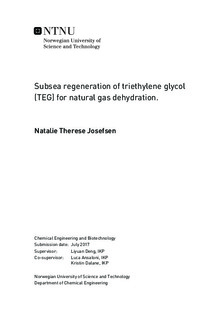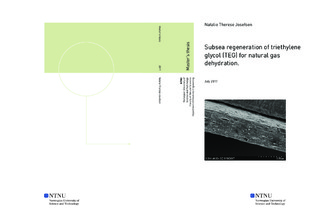| dc.description.abstract | The scope of this thesis was to examine the use of pervaporation technology with membranes for the regeneration of triethylene glycol (TEG) in natural gas dehydration. To reduce the need for offshore installations, subsea separation processes have been proposed. The subsea natural gas dehydration near the well is desirable as it results in smaller volume stream of natural gas and less water to damage the pipes. However, the conventional method of dehydration is not feasible for subsea operations due to factors, such as bulky design, large heating requirements and the need for continuously attention and maintenance, and another approach is needed. An alternative method for the natural gas dehydration is by using a closed loop membrane process design, using TEG as liquid absorbent.
Literature results on membrane absorbers using TEG for natural gas dehydration are available, but there is a lack of information about TEG dehydration using pervaporation technology, therefore experimental data is needed to validate computational models for process analysis. In this thesis, an experimental study of dehydration of TEG with pervaporation technology has been carried out using composite membranes with porous support of polypropylene (PP) and dense layer of Teflon AF2400. The addition of porous nanoparticles to the dense AF2400 layer was examined and innovative multi-layered membranes were developed for future use in pervaporation. The membranes were characterized in terms of compatibility to TEG, morphology and surface properties with scanning electron microscopy (SEM), scanning transmission electron microscopy S(T)EM and contact angle measurements. Furthermore, a method for analyzing TEG in aqueous solutions was developed with gas chromatography mass spectrometry (GC/MS) as this was vital to the pervaporation study.
The use of AF2400 as a dense layer in the composite membrane was confirmed as a suitable polymer after a compatibility study, as no TEG uptake was obtained. Results obtained from the pervaporation study show excellent separation factor of water from TEG, but rather low water flux through the membrane. In general, the water flux increased with increasing operating temperature and higher water content in the feed. The amount of TEG in the permeate was extremely low, increased slightly with increasing temperature and decreased with higher water content in the feed. The water permeance was enhanced with higher temperature and was shown to be rather independent of feed water concentration. The membrane showed long-term stability as the pervaporation experiments were performed over a time span of 1500 hours. The effect of adding ZIF-L nanoparticles to the dense layer of AF2400 in the composite membrane enhanced the water flux through the membrane. However, more TEG was found in the permeate, resulting in a lower separation factor, higher TEG permeability and lower water selectivity of the membrane. On the other side, the separation factor was still extremely high (>10000), suggesting that the addition of ZIF-L to the composite membrane with PP and AF2400 can be a suitable approach to improve the water permeance through the membrane. | |

